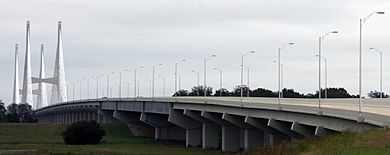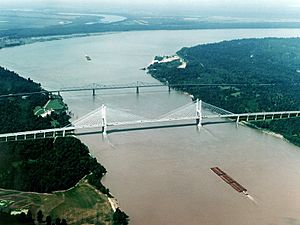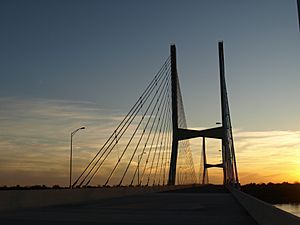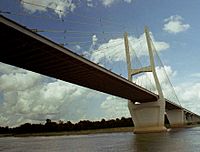Greenville Bridge facts for kids
Quick facts for kids Greenville Bridge |
|
|---|---|

The nearly completed bridge, viewed from the Arkansas side (October 2009)
|
|
| Coordinates | 33°17′14″N 91°09′15″W / 33.28722°N 91.15417°W |
| Carries | 4 lanes of |
| Crosses | Mississippi River |
| Locale | Refuge, Mississippi, and Shives, Arkansas |
| Characteristics | |
| Design | Cable-stayed bridge |
| Total length | 13,560 feet (4,133 m) |
| Width | 88 feet (27 m) |
| Longest span | 1,378 feet (420 m) |
| Clearance below | 122 feet (37 m) |
| History | |
| Opened | August 4, 2010 |
| Lua error in Module:Location_map at line 420: attempt to index field 'wikibase' (a nil value). | |
The Greenville Bridge is a special kind of bridge called a cable-stayed bridge. It crosses the mighty Mississippi River in the United States. This bridge connects Refuge, Mississippi, and Shives, Arkansas. It carries two important roads, US 82 and US 278. When it opened in 2010, it was one of the longest cable-stayed bridges in North America.
Before the Greenville Bridge, there was an older bridge called the Benjamin G. Humphreys Bridge. This old bridge was not wide enough and had no shoulders (extra space on the side of the road). It was also in a tricky spot on the river. Because of a sharp bend, barges and towboats often hit it. In 1994, experts decided a new bridge was needed. Construction started in 2001, and the new bridge opened in 2010. The old bridge was then taken down.
What is the Greenville Bridge Like?
The Greenville Bridge opened in 2010. It carries US 82 and US 278 over the Mississippi River. It is located about 0.5 miles (0.8 km) downstream from the original bridge, which was built in 1940.
This bridge was designed by a company called HNTB. It is a four-lane cable-stayed bridge. It has more than 2.5 miles (4 km) of bridge deck. Two tall concrete towers, 425 feet (130 m) high, hold up the deck. These towers are anchored by concrete piers that go 120 feet (37 m) deep into the riverbed. The bridge uses four sets of steel cables that connect to the top of the towers. These cables help support the bridge deck.
Each of the bridge's four lanes is 12 feet (3.7 m) wide. The outside shoulders are also 12 feet (3.7 m) wide. The inside shoulders are 8 feet (2.4 m) wide. The main part of the bridge, called the main span, is 1,378 feet (420 m) long. When it first opened, it was the fourth-longest cable-stayed bridge in North America.
Both the old and new bridges are mostly in Arkansas. This is because the state lines were set before the Mississippi River changed its path westward.
A Look Back: The Bridge's History
The first Greenville Bridge was built by the same company, HNTB. It opened in 1940 and was seen as a big step forward for the Mississippi Delta. It was a Truss bridge#Through trussthrough-truss design. Its main span was 840 feet (256 m) long. Until 1943, it was the longest bridge for vehicles on the Mississippi River.
Over time, more and more cars and trucks used the bridge. Sometimes, vehicles even hit the bridge. In the 1950s, an Air Force plane crashed into it. Even though the bridge was still strong, it wasn't good enough anymore. It only had two narrow lanes and no shoulders. If there was an accident or a very large vehicle, the bridge might have to close.
As river traffic grew, barges hit the bridge more often. By 1972, the Greenville Bridge had been hit more times than any other bridge on the Mississippi. The bridge was near a sharp bend in the river. Towboats and barges found it hard to make the turn and avoid hitting the bridge. Many times, they couldn't make the turn fast enough and crashed into it. The bridge became a danger to boats on the river.
In 1994, the Mississippi Department of Transportation studied how to improve the crossing for US 82. They suggested building a new four-lane bridge. The best idea was to build a new bridge about 0.5 miles (0.8 km) downstream from the old one. Then, the old bridge would be removed. More studies helped choose the best type of bridge. By 1995, a cable-stayed bridge was picked. This design worked best for the river and soil. It also gave enough space for boats to pass underneath. The plans for the new bridge were finished in 1999.
How the Bridge Was Built
HNTB, from Kansas City, Missouri, designed both the new Greenville Bridge and the original Benjamin G. Humphreys Bridge. The government provided $110 million to start building the main part of the bridge. This included the long sections supported by cables. Work on the main structure began in December 2001.
Companies worked together to build two large piers in the river. These piers were built using special floating structures. The last main section of the bridge was finished in April 2006.
Each state was in charge of building the approach roads and smaller bridge sections leading to the main bridge. For both states, these approach bridges were made of sections, each 120 feet (37 m) long. Construction on Arkansas's 2.5-mile (4 km) approach began in March 2006 and cost $66 million. Mississippi started its 1.8-mile (2.9 km) approach in April 2006, costing almost $86 million.
Many companies worked on different parts of the approaches. For example, one company built the road deck and concrete supports for the Mississippi side. Another company built Arkansas's approach bridge, which was 4,657 feet (1,419 m) long, and connecting roads. This part was finished in August 2009. The final steps, like adding a special surface to the bridge and painting lines, were planned in January 2010.
It took sixteen years from the first planning stages in 1994 until the Greenville Bridge opened. The bridge finally opened to traffic on August 4, 2010. The total cost of the bridge was $336 million. In 2011, the huge job of taking down the old bridge began. It was cut into small pieces to be recycled. This process was expected to finish by September 2012. Sometimes, the river had to be closed to boats to help with the demolition.




